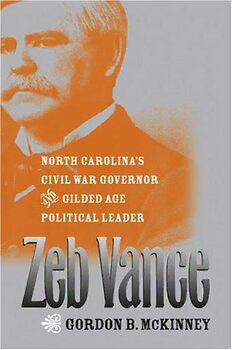
Zeb Vance: North Carolina's Civil War Governor and Gilded Age Political Leader PDF
Preview Zeb Vance: North Carolina's Civil War Governor and Gilded Age Political Leader
i Zeb Vance This page intentionally left blank Zeb Vance NORTH CAROLINA’S CIVIL WAR GOVERNOR AND GILDED AGE POLITICAL LEADER i Gordon B. McKinney TheUniversityofNorthCarolinaPress ChapelHillandLondon ©2004TheUniversityofNorthCarolinaPress Allrightsreserved SetinRuzickaandMonotypeClarendon byTsengInformationSystems ManufacturedintheUnitedStatesofAmerica Publicationofthisbookwasmadepossibleinpartbya generousgiftfromBenM.JonesIII. PortionsofChapter20werepreviouslypublishedas‘‘ZebulonVance andHisReconstructionoftheCivilWarinNorthCarolina,’’NorthCarolina HistoricalReview75(January1998):69–85. PortionsofChapter21werepreviouslypublishedas‘‘ZebVanceandthe ConstructionoftheWesternNorthCarolinaRailroad,’’AppalachianJournal29, nos.1–2(Fall2001–Winter2002):58–67;©2002byAppalachianJournaland AppalachianStateUniversity;usedwithpermission. Thepaperinthisbookmeetstheguidelinesforpermanenceanddurability oftheCommitteeonProductionGuidelinesforBookLongevityoftheCouncil onLibraryResources. LibraryofCongressCataloging-in-PublicationData McKinney,GordonB.,1943– ZebVance:NorthCarolina’sCivilWargovernorandGildedAgepoliticalleader/ GordonB.McKinney. p.cm. Includesbibliographicalreferencesandindex. isbn0-8078-2865-3(cloth:alk.paper) 1.Vance,ZebulonBaird,1830–1894. 2.Legislators—UnitedStates—Biography. 3.UnitedStates.Congress.Senate—Biography. 4.Governors—North Carolina—Biography. 5.NorthCarolina—History—CivilWar,1861–1865. 6.NorthCarolina—Politicsandgovernment—1861–1865. 7.NorthCarolina— Politicsandgovernment—1865–1950. I.Title. e664.v2m34 2004 975.6'03—dc22 2003027749 08 07 06 05 04 5 4 3 2 1 i CONTENTS Preface vii (cid:1)(cid:3) Challengestothe Acknowledgments xiii Compromise 185 (cid:1) WhatMannerofMan? 1 (cid:1)(cid:4) CampaignforReelection 200 (cid:2) AMountainBoyhood 5 (cid:1)(cid:5) ReturnedtoOffice 217 (cid:3) ScholarandSuitor 16 (cid:1)(cid:6) DefeatwithHonor 231 (cid:4) LawyerandApprentice (cid:1)(cid:7) Prisoner 248 Politician 31 (cid:1)(cid:8) ThePoliticsofReconstruction 264 (cid:5) Congressman 49 (cid:1)(cid:9) FrustratedPolitician 283 (cid:6) SecessionCrisis 65 (cid:2)(cid:10) TheBattleofGiants 302 (cid:7) ColoneloftheTwenty-sixth (cid:2)(cid:1) GovernorAgain 324 Regiment 78 (cid:2)(cid:2) UnitedStatesSenator 345 (cid:8) CampaignforGovernor 97 (cid:2)(cid:3) PartyLeader 366 (cid:9) BuildingaStrongNorth (cid:2)(cid:4) Farmers’AllianceandReelection 384 Carolina 110 (cid:2)(cid:5) Decline 397 (cid:1)(cid:10) RelationswiththeConfederate (cid:2)(cid:6) MonumentsandtheMan 406 Government 130 Notes 417 (cid:1)(cid:1) GrowingChallenges 152 Index 467 (cid:1)(cid:2) Protest 168 i ILLUSTRATIONS Vance’sbirthplace,ReemsCreek,BuncombeCounty 9 QuakerMeadows,BurkeCounty 19 DavidLowrySwain,ca.(cid:1)(cid:8)(cid:5)(cid:10) 21 HarriettNewellEspy,ca.(cid:1)(cid:8)(cid:6)(cid:2) 28 Asheville,NorthCarolina,in(cid:1)(cid:8)(cid:5)(cid:1) 32 RobertBrankVance,ca.(cid:1)(cid:8)(cid:6)(cid:3) 39 ThomasLanierClingman,ca.(cid:1)(cid:8)(cid:6)(cid:3) 51 Vancein(cid:1)(cid:8)(cid:5)(cid:8) 57 HenryKingBurgwynJr.,ca.(cid:1)(cid:8)(cid:6)(cid:1) 83 Vancein(cid:1)(cid:8)(cid:6)(cid:2) 113 WilliamWoodsHolden,ca.(cid:1)(cid:8)(cid:6)(cid:5) 205 Vancein(cid:1)(cid:8)(cid:6)(cid:6) 267 AugustusSummerfieldMerrimon,ca.(cid:1)(cid:8)(cid:7)(cid:9) 291 ThomasSettleJr.,ca.(cid:1)(cid:8)(cid:7)(cid:10) 307 Vancein(cid:1)(cid:8)(cid:7)(cid:6) 327 TheSwannanoaTunnelunderconstruction,(cid:1)(cid:8)(cid:7)(cid:8)–(cid:7)(cid:9) 336 FlorenceSteeleMartin,ca.(cid:1)(cid:8)(cid:8)(cid:10) 351 VancemonumentinPackSquare,Asheville,ca.(cid:1)(cid:9)(cid:3)(cid:10) 407 StatueofVanceintheU.S.Capitol 410 i PREFACE When I first started working on Zeb Vance as a research topic, I had an opportunitytosharesomeofmyideaswithagroupofseniorcitizensata meetinginBlackMountain,NorthCarolina.Duringthediscussionperiod that followed my presentation, one woman made several very insightful comments. After the end of the formal program, she came forward and introducedherselfasMrs.GlennTucker,thewifeofthebestscholarlybiog- rapherofVance.Shesharedwithmesomeofthechallengesthatsheand her husband had faced in working on Zeb Vance: Champion of Personal Freedom,aworkthathasstoodasthefineststudyofVance’slifefornearly 1 fourdecades. Unfortunately,thechallengesthattheTuckersfacedforcedthemtone- glecttheperiodaftertheCivilWar.SincethepublicationofZebVance,the amount of scholarship on the Civil War, Reconstruction, and the Gilded Age has expanded enormously. Making use of newanalytical approaches and ideas, including gender analysis and modernization theory, scholars havedevelopedmuchdifferentperceptionsoftopicssuchastherolethat raceplayedinshapingtheUnitedStatesduringthelatterpartofthenine- teenthcentury.TheresultistheneedforanewbiographyofZebulonVance thatplaceshiminthecontextofhistorians’rapidlychangingperceptions oftheAmericanSouth.Manyoftheinterpretationsinthisstudythatdiffer fromthoseofferedbytheTuckerswerefirstpresentedbyotherscholarsin articles and monographs. I have sought to convey the breadth and depth ofthisexcitingnewworkasaccuratelyaspossible.WhereIdisagreewith somescholarsonapoint,Ihavetriedtoexplainwhyinsomedetail,using primarysourcestosupportmyassertions. TheTuckerbiographywasnotthefirstscholarlyattempttounderstand Vance’shistoricalreputation.Asearlyas1914,J.G.DeRoulhacHamilton discussed important parts of Vance’s career in his highly partisan Recon- structioninNorthCarolina.Inthisdetailedaccountofeventsbetween1861 and 1876, Hamilton wrote approvingly of virtually everything that Vance did during the period, and he used quotations fromVance letters to sup- port his analysis.Unfortunately, Hamilton’s determination to attack Afri- can Americans and Republicans—especially William Woods Holden—at everypointlimitedthevalueofhisstudy.In1925,FrankOwsleytookthe opposite stand on thevalue of Vance’s contribution during the Civil War. Inhismonograph,StateRightsintheConfederacy,OwsleyaccusedVance and Georgia governor Joseph E. Brown of undermining the Confederate wareffort.OwsleywasparticularlycriticalofVance’sunwillingnesstoshare 2 stateresourceswiththeSoutherngovernment. The Civil War centennial in the 1960s encouraged many writers and publisherstoproducestudiesoftopicsthathadbeenneglectedfordecades. Likemanyotherworksfromthisperiod,JohnG.Barrett’sTheCivilWarin NorthCarolina,publishedin1963,concentratedonbattlesandthemove- mentsofarmies.Barrett’sbook,however,wasthefirstofthesecentennial monographstoalsoexaminethecontributionsthatVancemadeduringthe war.The picture of Vance that emerges from his study is one of a skilled 3 administratorwhokeptNorthCarolina’stroopswellsupplied. Startinginthe1970s,however,scholarsbegantoexamineVance’scareer inamuchmoredetailedmanner.Theresultoftheirinvestigationswasa considerablymorenuanceddepictionofhislife.Forexample,WilliamT. Auman challenged the picture of Vance as a champion of constitutional rights.Inseveralstudies,AumanarguedthatVancesanctionedharshtac- tics, including torture, against opponents of the Confederate war effort. Paul D. Escott confirmed Auman’s assertions and went on to point out thatVanceemployedasubtlestrategyofalternatingleniencyandfirmness toward peace advocates. Escott also analyzed the controversies between VanceandJeffersonDavisthathadpromptedOwsleytoclaimthatVance undercut the Confederacy. Escott recognized that Vance was actually at- temptingtoensurethatNorthCarolina’sfragileConfederatenationalism wasnurturedandsustained.Finally,analyzingtheoppositiontoVanceby RepublicansinwesternNorthCarolina,IdemonstratedthatVance’spost- warcareerwasasfullofcontroversyandpartisancompetitionaswasthe 4 caseduringthewar. In the last thirty years, a great many new studies have been pub- lishedthatprovidefullerinformationaboutseveralofthemenwithwhom Vance interacted. Max Williams continued the massive task of publish- ing the manuscripts of William A.Graham, one of Vance’s mentors dur- ing the war. In a biography of Henry K. Burgwyn Jr., Archie K. Davis gave a much needed corrective to our understanding of Vance as a sol- dier.WilliamC.HarrisprovidedadefinitivebiographyofVance’spolitical nemesisWilliamWoodsHolden,andHoraceRaperandThorntonMitchell publishedthesurvivingHoldenmanuscriptsthrough1868.E.StanlyGod- boldandMattieU.RussellwroteavaluablebiographyofWilliamHolland Thomas,apersistentVanceopponentinwesternNorthCarolina.JeffCrow composed a sympathetic sketch of Vance’s 1876 gubernatorial opponent Thomas Settle Jr. that uncovered some previously unrecognized features i viii preface ofthatcontest.Finally,ThomasE.Jeffreyproducedanoutstandingstudy ofThomasLanierClingman,themajorroadblocktoVance’spoliticalad- 5 vancementasayoungman. Alloftheseworkstakentogethermadeitobvi- ousthatVancewasnotaloneactoratanytimeinhiscareer,andthatany Vancebiographerneededtobeawareoftheactionsofmanyotherhistorical figures. OtherscholarssoughttoplaceVanceinthecontextofhisnativemoun- tainregioninwesternNorthCarolina.PhillipS.PaludandescribedVance’s angryattempttogainameasureofjusticeforthevictimsofanatrocityin MadisonCounty.JohnC.Inscoeprovidedthefirstconvincingdescription ofthemountainslaveowningclass;Vancewasaself-consciousmemberof thisgroup.JohnandIchronicledVance’seffortsasgovernortorelievethe suffering of the civilian population in the Appalachian counties.We also relatedhowVancetried,withfarlesssuccess,tocounterthegrowingwar- wearinessintheregion.KennethW.NoeandShannonH.Wilsonediteda seriesofessaysthatexploredtheimpactoftheentirewaronthemountain South;theseessayshelpedtoplaceVance’seffortsinabroaderperspective. MartinCrawford,inhisstudyofAsheCounty,allowedscholarstoconsider 6 theimpactofthewaronsmallmountaincommunities. Another group of historians evaluated Vance through the lens of their more complex understanding of the Confederate experience. Richard E. Beringer, Herman Hattaway, Archer Jones, and William Still Jr. tried to explain why the Confederacy failed. In the process, they absolved Vance ofanyblamefortheresultandcitedhisimaginativesupplypoliciesasan example of his positive contributions.George C. Rable examined the re- voltagainstpartisanpoliticswithintheConfederacyandcitedVanceasthe prime example of a successful state leader. Rable’s portrait of Vance as a masterpoliticalcraftsmanwhosoughttoaidtheConfederacybymaintain- ingatenuouspoliticaltruceinNorthCarolinaisespeciallyconvincing.My 7 owninterpretationofVance’swargovernorshipcloselyfollowsRable’s. Otherscholarsinvestigatedtherolesplayedbylargerforcesincreating the world in which Vance lived. Paul D. Escott drew a very convincing pictureoftheNorthCarolinapoliticalandeconomiceliteduringthelast halfofthenineteenthcentury.EscottfeaturedVanceasoneoftheleaders of this group and showed how the war governor became a major archi- tect of the postwar political system that limited the underclass’s access to power. On a broader scale, Laurence Shore described the ideological consistencyof Southern capitalists. His studyalso placed Vancewithin a muchbroaderperspectivethanhadpreviousstudies.AnneC.Rosemade asimilarpointwhensheusedVanceasanexampleofeliteadjustmentto VictorianAmerica.Inherinsightfulstudy,RoseexaminedVance’sdomes- I preface ix
